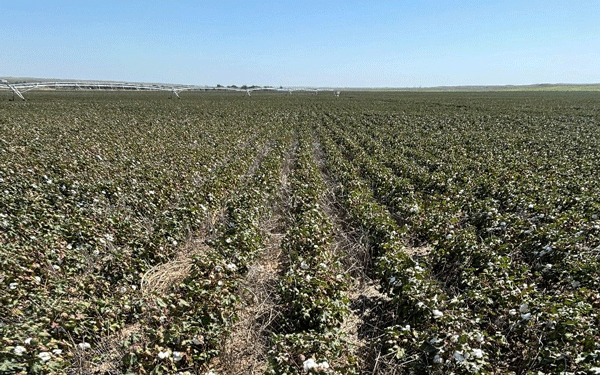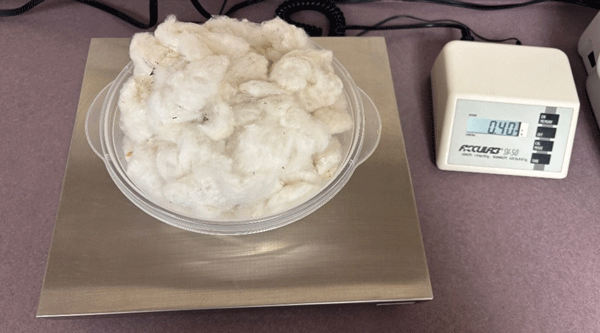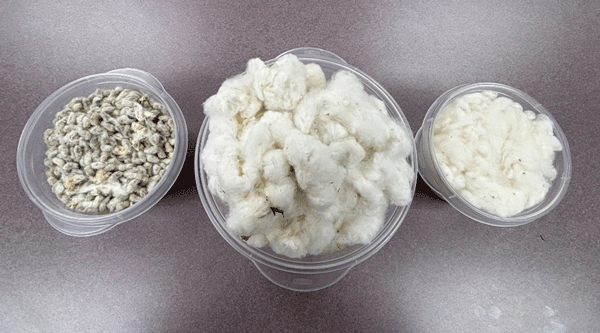It has certainly been a rollercoaster of a year for the 140,000 acres of cotton planted in Kansas in 2025. As we reach the end of the season, many look to estimate the potential yield of their crops, including cotton (Figure 1). Cotton yield estimation is similar to estimations made in corn and sorghum, but with a few significant differences. Cotton lint yield is a product of three primary factors: 1) bolls/acre, 2) boll weight, and 3) turnout (or lint percent). These vary by year, variety, node, and fruiting position. Two approaches can be used for cotton yield estimation: the quick estimate and the detailed estimate.

Figure 1. Bolls are opening in a cotton field in Seward County, Kansas, in early October, nearing the time for harvest aid application and harvest. Photo courtesy of Logan Simon, K-State Research and Extension.
The Quick Estimate
For many crop consultants and producers, the quick procedure for cotton yield estimation will give us an adequate idea of the crop’s yield potential.
Step 1: Count Bolls
Identify five to ten representative areas in the field. Mark a 3-foot section of row and count each harvestable boll or those from blooms that developed before the last effective bloom date, generally between August 20 and 25 in Kansas (Figure 2). Do not count bolls smaller than the diameter of a quarter. Divide this number by 3 to get bolls/row foot.

Figure 2. Cotton fruiting branch with four unopened bolls from positions that developed before and one (far right) that developed after the last effective bloom date. Photo courtesy of Logan Simon, K-State Research and Extension.
Step 2: Convert to pounds/acre
A general assumption can be made that every 10 bolls/row foot equates to one 480 lb bale. To convert from bolls/row-foot, multiply by a factor of 48.
Example of the quick estimate:
The factors that go into this calculation include:
- Number of bolls/row-foot (example: 18 bolls/row-foot)
- Conversion factor of 48
An optional step (shown below) is to convert lint yield (lbs/ac) to (bale/ac) using the conversion factor of 1 bale=480 lbs lint.

Example calculation:

The Detailed Estimate
This more precise procedure may be favored by crop insurance adjustors. This approach requires more time and attention to detail to refine estimates beyond the assumptions made in the quick estimate.
Step 1: Determine Row Spacing
The row spacing is as simple as measuring the distance between rows, in inches.
Step 2: Count Bolls
Follow a similar approach as outlined above, but use a 10-foot section of row (Table 1). Divide this number by 10 and multiply by 17,424 to get bolls/acre for cotton planted on 30-inch spaced rows.
Table 1. Conversion of the number of cotton bolls in 10 feet of row to the number of bolls/acre at various row spacings.
|
Row spacing |
Number of bolls in 10 feet of row |
||||||
|
100 |
150 |
200 |
250 |
300 |
350 |
400 |
|
|
(in) |
Number of bolls/acre |
||||||
|
40 |
130,680 |
196,020 |
261,360 |
326,700 |
392,040 |
457,380 |
522,720 |
|
38 |
137,558 |
206,337 |
275,116 |
343,895 |
412,674 |
481,453 |
550,232 |
|
30 |
174,240 |
261,360 |
348,480 |
435,600 |
522,720 |
609,840 |
696,960 |
|
15 |
348,480 |
522,720 |
696,960 |
871,200 |
1,045,440 |
1,219,680 |
1,393,920 |
Step 3: Estimate Boll Weight
Boll weight can be estimated by hand-picking a representative number of harvestable bolls in various parts of the field, counting them, weighing them, and then dividing the weight by the number of bolls (Figure 3). This will give a relatively accurate average boll weight for the yield estimate (Table 2).

Figure 3. Hand-pick a representative number of harvestable bolls in various parts of the field, count them, weigh them, and then divide the weight by the number of bolls. Photo courtesy of Logan Simon, K-State Research and Extension.
Table 2. Lint yields across a range of boll weights and number of bolls in 10 feet of row, assuming a harvest efficiency of 99% and 32% turnout.
|
Bolls in 10 feet of row |
Boll weight (pounds/boll) |
||||||
|
0.006 |
0.007 |
0.008 |
0.009 |
0.010 |
0.011 |
0.012 |
|
|
Lint yield (pounds/acre) |
|||||||
|
100 |
331 |
386 |
442 |
497 |
552 |
607 |
662 |
|
200 |
662 |
773 |
883 |
994 |
1,104 |
1,214 |
1,325 |
|
300 |
994 |
1,159 |
1,325 |
1,490 |
1,656 |
1,822 |
1,987 |
|
400 |
1,325 |
1,546 |
1,766 |
1,987 |
2,208 |
2,429 |
2,650 |
Step 4: *Estimate Harvest Efficiency*
Most Kansas cotton will be harvested with a brush-roll cotton stripper with a 99% harvest efficiency. This allows producers to maximize lint yield. This is highly affected by weather conditions and disease presence, which could result in lodging or excessive growth.
Step 5: Estimate Turnout
Turnout is determined at the gin as the proportion of lint in seed cotton (Figure 4) and is generally around 32% for stripper harvested cotton. Turnout can be affected by various factors, including weather conditions, variety, and overall crop health. An average value of 32% turnout can be used for stripper-harvested cotton in Kansas until data from previous harvests of the same cultivar at the same gin are available.

Figure 4. Turnout is determined at the gin as the proportion of lint in seed cotton. Photo courtesy of Logan Simon, K-State Research and Extension.
Example of the detailed estimate:
The factors that go into this calculation include:
- Number of bolls/acre (ex: 313,632)
- Weight per boll (ex: 0.009)
- Harvest efficiency (percentage; as a decimal for calculation) (ex: 0.99)
- Lint turnout (percentage; as a decimal for calculation) (ex: 0.32)

Example calculation:

Key considerations
- Accurate yield estimates, whether by the quick or detailed approach, start with identifying five to ten representative areas in the field.
- Quality estimates of harvestable bolls are essential for accurate yield estimation. Do not count bolls smaller than the diameter of a quarter.
- Harvest efficiency and turnout can be affected by various factors, including year (weather), variety, and overall crop health.
Logan Simon, Southwest Area Agronomist
lsimon@ksu.edu
Tina Sullivan, Northeast Area Agronomist
tsullivan@ksu.edu
Tags: cotton lint yield yield estimates